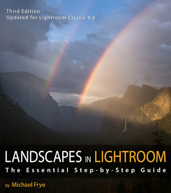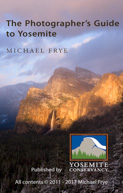Yosemite Photo Conditions
by Michael Frye | Mar 6, 2016 | Yosemite Photo Conditions
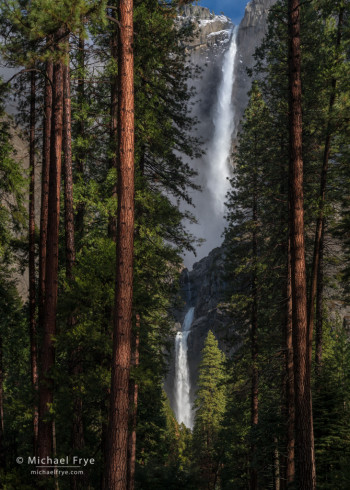
Morning sunlight on Yosemite Falls, Yosemite NP, CA, USA
After a very dry February the weather pattern has changed, with a series of storms dumping large quantities of rain and snow on California this weekend. Yosemite Valley received almost four inches of rain since Friday as a wet “atmospheric river” lined up to hit the northern and central parts of our state.
It was a warm system, with snow levels over 8,000 feet during most of the storm. The dry, sunny weather over the last month had already created exceptionally high flows in Yosemite’s waterfalls for this time of year, but all that rain over the last few days gave them an extra boost. I drove up to Yosemite Valley this morning and found the waterfalls roaring. They looked more like May than March. And there were small, ephemeral waterfalls everywhere.
Before the storm started to clear this morning I photographed Lower Yosemite Fall in soft light, and then as the sun began breaking through I decided to stay and photograph the upper and lower falls. The sun reaches this waterfall earlier in the morning during March than it does in April or May, making the light much more interesting. You don’t get many opportunities to photograph it this time of year with so much water – and with mist around the upper fall. Here’s one of the photos from this morning.
(more…)
by Michael Frye | Feb 28, 2016 | Yosemite Photo Conditions
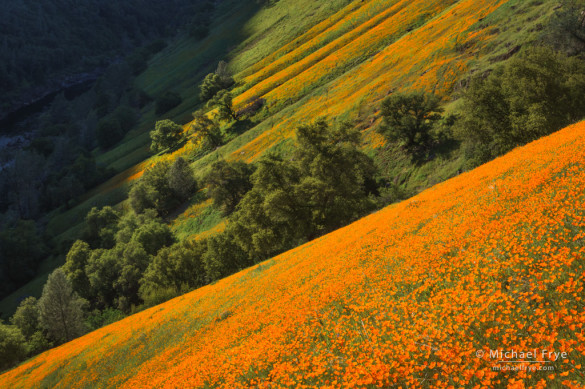
Poppies in the Merced River Canyon, April 2014
Spring has arrived early this year. It seems the poppies in the Merced River Canyon west of Yosemite liked the warm February weather we’ve been having, and they’ve been appearing in greater numbers over the last two weeks. On Friday, when Claudia and I drove up to Yosemite Valley for the Yosemite Renaissance opening reception, we saw some vibrant patches of poppies on the north side of the canyon (opposite Highway 140) a few miles easts of Briceberg. Other spots further east were just starting to show tinges of orange, but I expect those areas will become more colorful. It’s shaping up to be a good year for poppies in the canyon, but it’s just getting started, and the flowers are likely to last for several more weeks if the weather cooperates.
I’ve also seen photos of brilliant poppy displays in the southern Sierra foothills (east of Fresno and Bakersfield). And Death Valley is having a good bloom right now also. But southern California has received below-average rainfall so far this winter, so some of the best wildflower spots in the state like the Carrizo Plain and Antelope Valley probably won’t have great displays this year unless they get more rain soon.
(more…)
by Michael Frye | Feb 19, 2016 | Light and Weather, Yosemite Photo Conditions
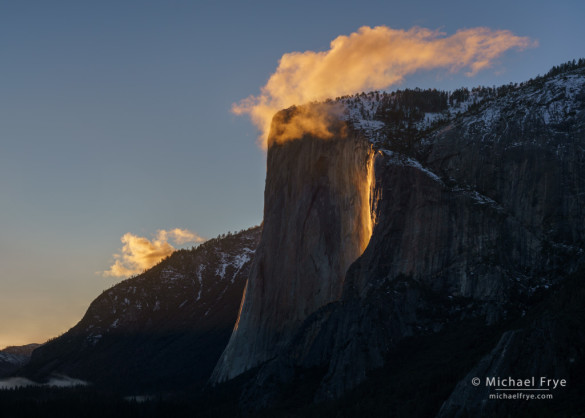
El Capitan and Horsetail Fall at sunset, Yosemite
I rose early yesterday morning to go up to Yosemite Valley, thinking the storm might clear just after sunrise. But showers persisted, and the sun didn’t break through until almost ten o’clock. By the time I finished photographing it was almost noon, so I decided to stay in the valley until sunset.
In the afternoon typical after-storm condensation clouds formed around the rim of the valley. Thinking those clouds might add something to a photograph of Horsetail Fall, and allow me to capture something a little different from my other images of this waterfall, I headed for a spot with a good overall view of El Cap and Horsetail.
(more…)
by Michael Frye | Feb 17, 2016 | Yosemite Photo Conditions
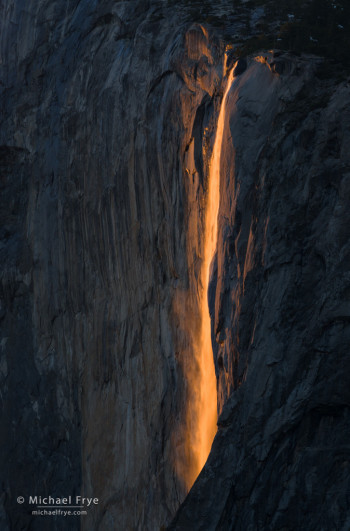
Horsetail Fall last night, 5:27 p.m.
February has been completely dry around here so far, with very warm temperatures. That warm weather has been melting the snow on top of El Capitan and creating a strong flow in Horsetail Fall – easily the most water in the fall since 2010. Yesterday was another clear, warm day (the high in Yosemite Valley was 67 degrees), with nearly ideal conditions for Horsetail. I wondered when I might see such conditions again, so I decided to head up to Yosemite Valley.
A first-hand look at Horsetail actually revealed less water than I expected. With the exceptionally warm weather we’ve been having I thought Horsetail would really be gushing, perhaps even approaching the high flow shown in this photograph from 1995. But nevertheless it was flowing well. I’d say the water level was a little above average for February (and, of course, way more than anything we’ve seen during the last four years of drought).
(more…)
by Michael Frye | Jan 31, 2016 | Light and Weather, Yosemite Photo Conditions
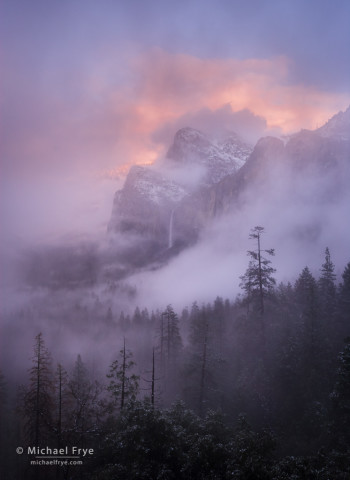
Misty sunset over Bridalveil Fall, Yosemite NP, CA, USA
Two weather systems have brought over two inches of precipitation to Yosemite Valley since Friday night. It was very warm at the beginning, with snow levels at 9,000 feet, but now the temperature has dropped, and it’s starting to snow.
I can even see flakes falling outside my window in Mariposa, at 2,800 feet, but it’s a little too warm for the snow to stick.
It looks like the storm might clear this afternoon, but these things are always hard to predict. Radar images show the tail end of the precipitation approaching, but that can be deceiving, as showers often linger over the mountains longer than you would otherwise expect. I’ll be keeping a close eye on things this afternoon, especially since there’s no precipitation in the seven-day forecast, so this might be the last chance to photograph a clearing storm for awhile. We’ll see what happens!
In the meantime, here’s a photograph from a clearing storm back in January of 2012. Chances are low that this current storm will bring an opportunity like this, but you can always hope.
— Michael Frye
(more…)
by Michael Frye | Jan 20, 2016 | Yosemite Photo Conditions
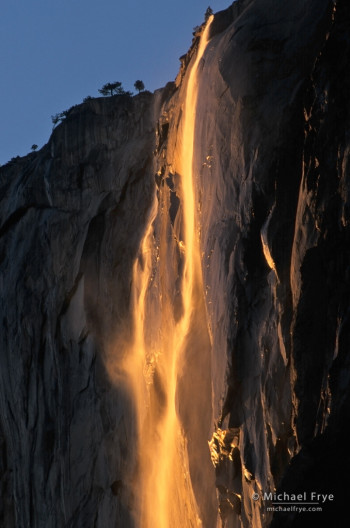
Horsetail Fall at sunset, Yosemite
We’re getting close to Horsetail Fall season, and I’m getting lots of questions about the water flow and the right time of year to photograph it.
As I said in my last post, there’s a healthy snowpack at higher elevations of Yosemite. Badger Pass ski area still reports 60 inches of snow on the ground at the base of the mountain (7,200 feet), and 72 inches at the top (8,000 feet). Horsetail’s small drainage on top of El Capitan lies at similar elevations, but faces south, and the slopes of Badger Pass face north. That means Horsetail’s drainage gets more sun, and the snow melts faster. But there should still be at least three or four feet of snow on top of El Cap right now, and it’s hard to imagine how all of that could melt between now and the third week of February. After four years of drought, it looks like we’ll finally have a good flow in Horsetail Fall at the right time of year.
But water flow is just one element. You also need the sun to set at the right angle to backlight Horsetail and make it turn orange, yet have the cliff behind it in the shade, so that the glowing, backlit, orange water is set against a dark background. My best estimate is that this happens between February 16th and 23rd, and perhaps even a few days beyond. (I delve into more detail about all that here.)
(more…)













